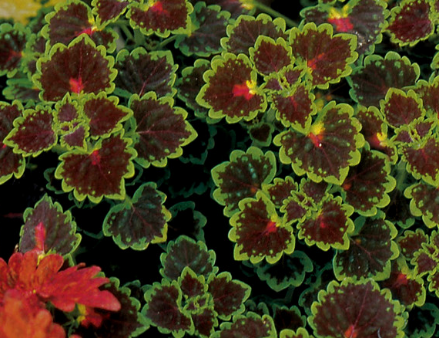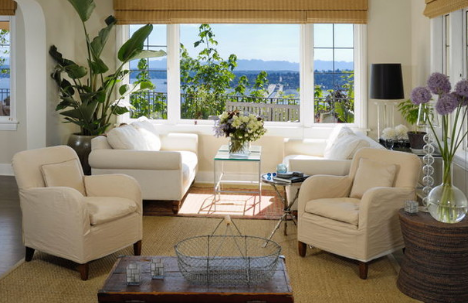

For most houseplants, light from west-facing windows is a welcome compromise between the bright but often weak light coming from east-facing windows and the direct and often very bright light coming in through south-facing windows. Therefore, plants that prefer a little more light but cannot withstand hot direct sunlight prefer this exposure the most. It is often a good location for flowering houseplants, as well as plants with variegated or even non-green leaves, as it tends to enhance the color of the leaves.
The west-facing windows are also a great place for many plants, and they are suitable for eastern or southern illumination, so feel free to try to include them. Those who prefer to shine eastward may need to stay away from windows or shaded by light curtains, while those who prefer to shine southward may need to move closer to light. Either way, you’ll have plenty of options to fill your space.
Most plants that thrive in west-facing windows aren’t that picky about their growing conditions. Of course, they love light, but other than that, they generally perform well in standard household humidity and temperatures, although they prefer to stay away from air currents and be protected from extreme temperatures. Some people prefer to keep it evenly moist; Some people like to stay moist. Others may dry out between waterings.
Feed them as they grow, usually from spring to fall. If using liquid fertilizer, use a quarter of the strength weekly or half the strength every two weeks.

West-facing windows receive direct sunlight during the brightest hours of the afternoon – which is especially beneficial for flowering plants – but also during the hottest times. If plants receive too much sunlight or heat, especially if they also receive light from other windows, their leaves may be scorched and show signs of elongated growth. If this is the case, move the plant away from direct sunlight or provide filtered light during the hottest part of the day. During the summer months, the plants may also need to stay away from hotter places and return in the winter when the sun is weak.
If a plant is not growing and lush, it may not be receiving enough light, especially when the incoming light is filtered by buildings and trees. If so, move the plant closer to the window to increase the amount of light it receives.

The leaves are eye-catching. Western exposure allows the best in many popular houseplants, which are grown for their unusual leaves. If you’re looking for a houseplant with unexpectedly bright, velvety leaves that range in color from green to yellow, orange, red, maroon, and purple, then coleus is a great choice. Its brightly colored leaves stand out in any space and are relatively easy to grow.
Keep the soil evenly moist, but don’t let the plants stand in the water. Half-intensity fertilizer is applied every two weeks from spring to autumn, and the amount of fertilizer is reduced in winter. Bright or even direct sunlight will enhance the color of the leaves, but if the sunlight is too strong, the tips will be scorched. It is satisfied with the average indoor temperature and humidity levels, although it does like to be a little cooler when it is not growing. It can also bloom, but it is quite rare indoors.
More: Other plants with interesting foliage include blood leaf (Iresine Hersstii), croton (Codiaeum variegatum), false Aralia (Schefflera beautifulissima), dracaena (Dracaena reflexa), pandanus (Pandanus veitchii) and red leaf plant (Cordyline fruticosa) (Source of leaves) hula skirts used for outdoor planting.
Caution: Croton, pear peel, and sharp-leaved plants are toxic when ingested.

Blossoming favorites. One of the advantages of the bright light from the west-facing windows is that flowering houseplants are usually happiest there. Among them is geranium, which has long been a favorite indoors. Before considering it as “your grandmother’s houseplant”, consider its advantages: flowers of many colors, bright leaves, easy maintenance, the option of hanging baskets and the ability to blend in with different decorative styles.
To keep geraniums happy, water it thoroughly and let it drain completely, then let it dry slightly before watering it again. Water a little less in winter, but don’t let the roots dry out completely. Apply a half-strength fertilizer every two weeks from spring to fall, or a quarter-strength fertilizer once a week. Prune regularly and pinch the stems to keep the plant in good shape.
MORE: Other popular flowering houseplants that thrive in west-facing windows include rhododendrons (Rhododendron indica), gardenias (Gardenia jasminoides), hibiscus (Hibiscus spp.), New Guinea impatiens (Impatiens hybrids), Persian violets (Exacum affine) and clover (Sorrel).

Succulent sun lovers. Aloe vera may be known for its healing juice, but it’s also a good choice for houseplants. Its ribbon-like foliage looks perfect for home in almost any setting, but it shines especially in modern or rural spaces. It is also easy to grow and can handle some oversights.
For best results, plant it in a well-drained cactus mix and water it regularly from spring to fall, let the pot drain thoroughly after watering, and allow the mixture to dry about half an inch from the top before watering. In winter, watering is almost completely reduced and once a month.

Aloe vera is suitable for growing at normal home temperatures and humidity, but keep away from windy and cold places; The leaves are mostly water, so they will freeze if it’s too cold. If the leaves become too pale, provide more light. You can start a new plant from the plantlets that are formed.
More: While aloe vera is a great succulent option, you may also want to consider the easy-to-grow jade tree (Crassula ovata) or thornless yucca (Yuccaelephantipes), which require similar care. Another option is to set up a small indoor cactus garden, as many of them also enjoy the bright afternoon sun provided by the west-facing windows.
Caution: Aloe vera, eucalypa and yucca are toxic when ingested.

No soil is required. Many bromeliads, which are commonly sold as houseplants, are good choices for west-facing windows. In fact, air pineapples are often sold as “air plants”, which may be a factor in their growing popularity. Although it does not survive solely on air, it does not require soil and can therefore be displayed in a small vegetable garden, attached to a piece of wood that hangs on a wall or placed on a table, or is used as a focal point in a glass container hung on a window.
While the iron orchid may not need soil, it needs some care, which includes providing adequate moisture. Several times a week, gently water the grassy leaves until they are barely wet, then allow them to dry completely (you can use a sprayer if you prefer). Apply a quarter concentration of fertilizer twice a month when watering, as these plants absorb nutrients through their leaves. Provide good air circulation. If your plant has brown tips, the humidity may be too low.
Tielan can withstand direct sunlight in the winter, but may require more filtered light in the summer. It can also withstand indoor temperatures of up to 90 degrees Fahrenheit (32 degrees Celsius) and requires higher temperatures to bloom.
More: Other popular bromeliads include red bromeliads (Neoregelia carolinae), Cryptanthus spp., Queen’s tears (Billbergia nutans), and vase or urn plants (Aechmea spp.).

One of the most striking indoor “trees” is the bird of paradise with its broad foliage and tropical flair. Give it plenty of room to grow as it can reach up to 6 feet tall.
The bird of paradise prefers to stay indoors most because the west-facing windows provide bright light, but if the direct sunlight it receives is very bright, you may need to provide some screens in the form of light curtains. Water thoroughly, but let it dry between waterings and let it almost dry in the winter. If it is located in a particularly bright place, it needs to be watered more often. Semi-concentrated fertilizer is applied twice a month in spring and autumn.
More: The bird of paradise may be the most striking, but there are other options to fill the large space in the west-facing location, including avocado (Persea americana), dwarf citrus (Citrus spp.), butterfly palm (Chrysalidocarpus lutescens), jaggery palm (Caryota urens) and sago palm (Cycas revoluta).
Caution: Bird of Paradise, Butterfly Palm, Brown Sugar Palm, and Sago Palm are toxic when ingested.

Seasonal stars. The long-lasting bright flowers of white, pink, red, orange and lavender are among the benefits of growing holiday cacti: the Christmas cactus (Schlumbergera Bridgesii), the Thanksgiving cactus (S. truncata) and the Easter cactus (Rhipsalidopsis gaertneri or Hatiora gaertneri). The common name refers to the time of year when they bloom, and while there are some subtle differences between them, they require roughly the same care overall.
These cacti need fertile soil and keep it evenly moist. From spring to summer, during the growing period of the plant, apply about a quarter of the concentration of fertilizer once a week, and then reduce the amount when flowering. They don’t want to be in direct sunlight, but they do like the light coming in from their west-facing windows and can survive in normal temperatures most of the time after flowering.
Once the buds begin to form, usually around October or November, flowering is triggered by shorter days and a drop in temperature at night. Place them in a place where they can tolerate 12 hours of darkness to stimulate flowering. You should also reduce watering at this time. Easter cacti take longer to bloom.
More: If you’re looking for other holiday plants for your west-facing windows, consider using solitary arphyllum (Vermilion hybrid) and poinsettia (Euphorbia) for the winter holidays, chrysanthemums (Chrysanthemum spp.) for Thanksgiving, and lilies (Lilia spp.) for Thanksgiving. and primula (Primula spp.) as an indoor tribute to spring.
Caution: Lone, poinsettia, chrysanthemums, lilies, and primroses are toxic when ingested.

Trailing form. There’s a reason why English ivy is a tried-and-true houseplant, especially when kept in hanging baskets at home. It grows quickly, producing rows of green or variegated leaves downwards, but it can also be trained to climb. It can handle different humidity and light levels and does not require special care.
Keep the soil evenly moist and fertilize with a quarter of the concentration of fertilizer every week. It prefers bright light, but avoids direct sunlight in summer. Trim or pinch to keep its shape.
More: Other options for hanging baskets include spider grass (Purple dew grass) and geranium (Geranium spp.).
Caution: English ivy, spider grass, and geraniums are toxic when ingested.